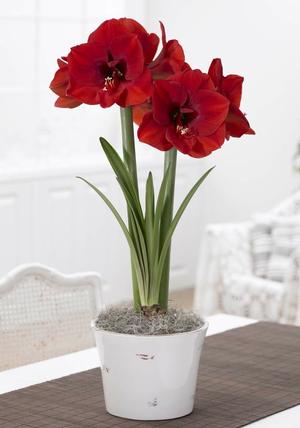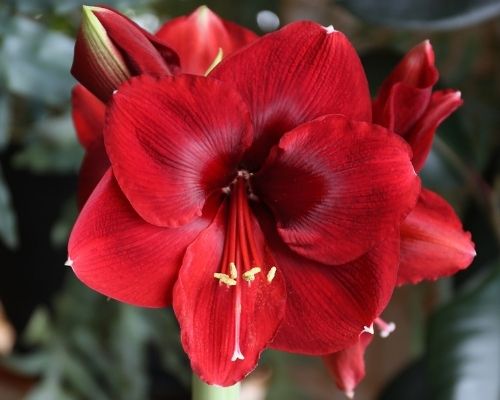Better Bulbs Produce Better Blooms
If you've shopped around for amaryllis bulbs, you may have wondered whether there's really much difference between one bulb and another. In fact, there is, and the variables of origin, variety and bulb size all factor into price and performance.
Origin
Most amaryllis bulbs are produced in Holland, Brazil, Peru, South Africa and Israel. Dutch amaryllis are grown in temperature-controlled greenhouses to ensure quality and uniformity. Amaryllis grown in Israel and the southern hemisphere, typically bloom earlier.
Though it’s difficult to predict exactly when a bulb will come out of dormancy and how quickly it will grow, non-Dutch bulbs typically take 5 to 7 weeks to bloom whereas Dutch amaryllis bulbs take 8 to 12 weeks. Combine these natural bloom time variations with a staggered planting schedule and you can have amaryllis in flower from December through early March.
Note that the bloom time estimates given above apply to bulbs that are planted in late fall. When amaryllis bulbs are planted during December or January, they come into flower more quickly.
Variety
There are dozens of different amaryllis varieties and each has its own characteristics as far as flower style and color, bloom time, stem height, flower size and typical number of blooms. This means that performance is in part determined by genetics.
The ‘Nymph’ series, for example, typically produces large flowers on relatively short stems. Newer varieties such as ‘Lagoon’ and ‘Red Pearl’ have very large blooms (10”) compared with standard (7”) varieties. Cybister amaryllis, sometimes called spider amaryllis, have narrow petals and the bulbs are noticeably smaller than standard amaryllis bulbs.
Amaryllis varieties that are easy to propagate and widely available typically cost somewhat less than varieties that are new to the market, difficult to propagate or in short supply. You’ll also find that unusual varieties that have a limited demand may only be available in one or two bulb sizes.

Size
There is a direct correlation between the size of an amaryllis bulb and the number of stems and flowers it will produce. Bulbs are storage vessels, and bigger bulbs contain more stored energy to fuel growth and flowering.
You'll get the biggest flowers and the most blooms from jumbo-sized bulbs. That said, not all amaryllis varieties are available in jumbo sizes. Some varieties naturally produce smaller-than-average bulbs, yet still put on an impressive display.
The most popular varieties, such as Red Lion and Apple Blossom, are usually available in a range of bulb sizes. Mid-size bulbs are still a good buy. They are less expensive than the jumbo bulbs and can be planted into smaller containers. You can get a great look by combining two or three of these bulbs in a large pot. Or, for a season-long display, plant up a container that includes a combination of amaryllis bulbs and indoor plants such as cyclamen or oxalis.
Amaryllis bulbs are measured in centimeters around the widest part of the bulb. In the photo below, the bulb on the far right measures 26/28 centimeters in circumference. The one on the far left is a full 8 cm larger, measuring 34/36 cm. Though the number of stems and flowers can’t be guaranteed, here’s what you can expect from each size bulb:

26/28 cm – 1 stem (occasionally 2) with 3 to 4 flowers
28/30 cm – 1-2 stems with 3-4 flowers per stem
30/32 cm – 2 stems with 3-4 flowers per stem
32/34 cm – 2 stems (occasionally 3) with 4-5 flowers per stem
34/36 cm – 3 stems with 4-5 flowers per stem

Other Things to Know About Amaryllis Bulbs
• Larger bulbs produce thicker, stronger stems than smaller bulbs.
• Jumbo amaryllis bulbs (34 to 40 cm) are a full year older than smaller bulbs. Since these bulbs must be kept in the ground for an extra year, prices are usually higher.
• Amaryllis bulbs may produce stems and leaves at the same time. More commonly they produce flower stems first, followed by leaves. Sometimes multiple stems emerge together, but it’s also normal for the first stem to bloom and die back before the second stem emerges.

